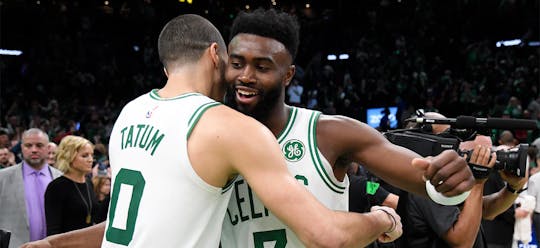As the pointing Leonardo DiCaprio meme perfectly illustrates, there’s nothing quite like the rush you get when you feel like you've already seen something before. Some may call it déjà vu, others just call it plain history.
It's happening right now in the NBA with some teams being caught in oddly familiar situations. We'll point three of them out and see what the current teams can take away from their past counterparts. Whether they learn from history or make Winston Churchill cringe in his grave, this should offer a preview into each team's near future.
Charlotte Hornets vis-à-vis 2014-15 Phoenix Suns

The Charlotte Hornets have a lot of good things going for them, but all those good things want the ball. They signed Terry Rozier and benefitted from Devonte' Graham's improvement last year. Then they drafted LaMelo Ball, who is Pistol Pete Maravich reincarnated with 5.7 million Instagram followers and a very supportive father.
Those three point guards are most effective with the ball in their hands. Hornets coach James Borrego started the season by bringing Ball off the bench, but an ankle injury to Rozier opened a spot for Ball to start. Rozier was having a career year before the injury, Graham has recovered from a gruesome start to the season, while Ball has been flashing all the tools that scouts were raving about, especially his passing skills.
The 2014-2015 Phoenix Suns, on the other hand, were coming off a surprising 48-win season that almost propelled them into the playoffs. But then the Suns thought: “You know what's better than small ball? Smaller ball!”
The Suns already had a dynamic, undersized backcourt duo in Most Improved Player Goran Dragic and Eric Bledsoe, but decided to also snag Isaiah Thomas with a relatively cheap sign-and-trade with the Sacramento Kings.
Phoenix started the season off with a frantic offensive pace at 106.5, far exceeding the second place Golden State Warriors at 99.3. Predictably, they had issues on defense and struggled to find minutes to satiate all three point guards.
The Takeaway: Be careful with the changes you make

That Suns team quickly pulled the plug on their three-guard experiment, trading Thomas to the Boston Celtics and Dragic's expiring contract to the Miami Heat.
Sitting in the middle of the Western Conference heap, Phoenix got three first round picks (one of the picks from Miami is set to pay off in the 2021 draft), an over-the-hill Danny Granger, Marcus Thornton, and John Salmons, whom they eventually waived.
The Suns then tried to re-shore their backcourt by trading for Brandon Knight, whose later extension cost them a lot of money that’s not proportional to his production. They turned into a perennial lottery team, until this season when Devin Booker and Deandre Ayton, together with Chris Paul, look to finally end their playoff drought.
Today’s trio of Hornets guards are on comparatively different contracts, but are heading toward the same outcome. It's only a matter of time until LaMelo develops into their obvious lead playmaker and benching him would be a waste. Who between Graham or Rozier gets a reduced role is going to be a tough decision for Borrego.
Whatever Charlotte ends up doing with their three guards -- whether they flip one or two of them for a much-needed big or they ride the miniature ball wave -- they can't end up wasting assets in a pinch like what the Suns did.
Brooklyn Nets vis-à-vis 2010-14 Miami Heat

Kevin Durant left the Golden State Warriors so he could be free of the superteam tag and start an independent chapter to his legacy. But then he went to Brooklyn and eventually formed another superteam with Kyrie Irving and James Harden.
The Nets had KD and Kyrie to start the season then decided to pluck an unhappy Harden out of Houston by draining almost all of their assets and trading away the remaining vestiges of their fun 2019 playoff team.
So far, the Nets have been as advertised: an offensive juggernaut and a defensive whimper. Having Durant, Harden, and Irving take turns with the ball has resulted in Brooklyn ranking in the top five in offensive efficiency, which almost patches up their bottom five defense.
It's possible for Brooklyn to keep winning with their current configuration, but it remains to be seen if their offensive prowess will be enough to win a title.
The player empowerment movement that allowed Durant, Harden, and Irving to team up in Brooklyn started with LeBron James taking his talents to South Beach where Dwyane Wade and Chris Bosh were waiting.
With Cleveland unable to bring in championship talent, LeBron built his own powerhouse team in Miami in 2010. From The Decision to their Game 6 loss in the Finals to the Dallas Mavericks, the Heat's Big Three faced scrutiny beyond what any other team had faced before. They quickly found out that when you promise “not one, not two, not three, but seven titles” and bring back none, you're going to need to make changes.
The Takeaway: Win now because it's gonna be over sooner than you think

While "The Heatles" were much better defenders than Brooklyn's trio, they also found out they needed way more pieces to match up against the burly Eastern Conference back then. Following their Finals loss, the Heat added Shane Battier, who unlocked the Heat's small ball lineup, and Norris Cole, a key bench piece.
They won the title in 2012 against a young Oklahoma City team that had Durant and Harden. Finally getting a ring for the King, Miami continued to add pieces through shrewd financial moves, landing Ray Allen, Chris Andersen, and Rashard Lewis, all of whom played key roles in the Heat's second title conquest in 2013.
As constructed, Brooklyn doesn't have the Shane Battier-type piece that alleviates problems on both ends of the court. They have a capable shooter in Joe Harris, a serviceable swing man in Jeff Green, and a post-Lob City DeAndre Jordan. They have other gutsy role players, but probably lack the pieces to match up in a seven-game series against the East's other elite teams like Philadelphia.
Whether or not they find their own versions of Andersen, Lewis, Udonis Haslem, and Mike Miller will most likely decide how far they will reach.
Perhaps the biggest problem of Brooklyn is if Irving and Harden will be willing to cede control to Durant. While it’s all fine and egalitarian for now, they'll find out that possessions become scarcer in the playoffs and only one of them can truly take over the game in big moments. Wade and Bosh realized that right after their Finals loss in 2011. Brooklyn's Big Three will have to litigate the same problem at some point. Giving the ball to the seven-footer with Allen Iverson's crossover and Allan Houston's jumper is probably their best bet.
The Nets will have to figure this out quick. After losing to San Antonio in the 2014 Finals, LeBron went back to Cleveland and won one with Irving. All of Brooklyn’s Big Three are only signed until next season with player options for the 2022-2023 season. With the Nets trading away multiple draft picks and assets to assemble this team, there’s not a lot of time or resources for them to rebuild.
Boston Celtics vis-à-vis late 90s Toronto Raptors

It took a while and several detours into other star signings, but the Celtics’ trove of picks and assets have brought them their core of the present and future in Jayson Tatum and Jaylen Brown.
Brown, who was picked third in the 2016 Draft, has been improving every year. He broke out this season, averaging career-highs in every statistic. He channeled his elite athleticism into a two-way destruction, while also serving as a leader for both the Celtics and all NBA players in social justice matters.
Tatum, the third pick of the 2017 Draft, was, is, and will always be a bucket. There are few players in the league who can score as smoothly as Tatum. This season, he's taken on more playmaking duties, averaging a career-best 4.8 assists per game as he continues to improve as a pick-and-roll navigator.
It's rare for teams to have two elite swingmen, let alone draft and develop two all-around All-Stars. The Toronto Raptors luckily drafted and developed such early in their life as an expansion team. In 1997, they picked Tracy McGrady fresh out of high school then followed that up by drafting McGrady's cousin Vince Carter in 1998.
Carter was electric right from his first game then immediately became legendary for the television masterpiece that is the 2000 Slam Dunk contest. It took McGrady a bit longer, but by the 1999-2000 season, he was already in Toronto's starting lineup, flashing his effortless scoring prowess and uncanny playmaking.
The Takeaway: The grass isn’t always greener on the other side

Toronto keeping the Carter and McGrady tandem was one of the NBA's biggest what-ifs. Rookie contracts were different back then as players hit unrestricted free agency much earlier. McGrady already desired a bigger role with a different team in the summer of 2000 so he was signed and traded to the Orlando Magic.
What followed was the tragedy of TMac. In Orlando, he was supposed to carry the team with Grant Hill, but Hill never regained his old form after several devastating ankle injuries. McGrady moved on to the Houston Rockets in 2004 where he and Yao Ming threatened to take over the West.
By then, McGrady's back started acting up as he never played a complete season with the Rockets. Combined with Yao's own injury woes, TMac only got as far as the Western Conference semifinals with the Rockets. His peak tragically cut short, TMac got closest to an NBA title as a member of the 2012-2013 San Antonio Spurs that lost to the Heat in the Finals.
Carter went on his own expedition. The most popular in the NBA during his prime, Carter had a falling out with the Raptors after consecutive disappointing seasons. In 2004, he was traded to the Nets, where he helped New Jersey make the playoffs, but never the Finals.
He rode out his prime with New Jersey, before collecting Orlando Magic, Phoenix Suns, Sacramento Kings, Memphis Grizzlies, and Atlanta Hawks jerseys to end his career.
TMac and Carter could have been special and could have won a title together, especially in a talent-barren Eastern Conference of the early 2000s. But both demanded their own team, realized they needed help to win, and wound up never finding the perfect partner.
Tatum and Brown are the ideal building pieces for any NBA team. It's up to them and the Celtics to stay together and see this thing through.




